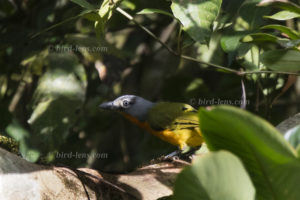 To discover a Fiery-breasted Bushshrike (Malaconotus cruentus) in the mountain rainforest of south-western Cameroon is a very special privilege of a birding trip. As soon as we started to climb a hiking trail at Mount Kupe, we saw the mountain chain of Mt. Kupe, Mt. Oko near Kumbo and Mt. Cameroon. A beautiful chain of mountain rainforests.
To discover a Fiery-breasted Bushshrike (Malaconotus cruentus) in the mountain rainforest of south-western Cameroon is a very special privilege of a birding trip. As soon as we started to climb a hiking trail at Mount Kupe, we saw the mountain chain of Mt. Kupe, Mt. Oko near Kumbo and Mt. Cameroon. A beautiful chain of mountain rainforests.
Right in the beginning we could observe some of the primeval forest specialists, such as Speckled Tinkerbird (Pogoniulus scolopaceus) or the Yellow-billed Barbet (Trachyphonus purpuratus) in the canopy. Impressive birds. Especially when you can see them in the spotting real good. The view up into the canopy is quite exhausting – if you perform it for a while. But when our bird guide was able to detect a large, powerful bird high up between epiphytes and mosses of the canopy, all eyes were directed upwards again. These plants occur only in areas with frequent rainfall and high humidity. For this purpose, the light tropical rainforest of Mount Kupes is predestined. It is a Fiery-breasted Bushshrike, a colorful bird from the family of Bush shrikes (Malaconotidae). The Fiery-breasted Bushshrike first stands on a thick branch and moves there without great haste. Despite its striking colors, it still looks very unobtrusive and can easily be overlooked. He reminds me a bit of a Cutia (Cutia nipalensis), one member of the Shrike Babblers from the Himalayas. Dave uses the tape intensively with the calls of the Fiery-breasted Bushshrike. Suddenly the bird disappeared. We are afraid to have lost him. But then he comes down – almost without feeling his approach. He sits briefly on a thick, dry branch (almost) in the open, beautifully illuminated by the sun, which shines through the open crowned roof of this selectively logged mountain forest. Wonderful is to see the gray head, the yellow belly, the orange-yellow chest, the green top and the gray head. The bright blue eye with the dark iris is distinctive. Only a few leaves obscure him the 6 seconds he is there to admire. No more than 30 meters from us, he squats motionless, almost at the same level of our group staying. The bird is probably looking for the rival who has emitted the calls. Immediately I turn right to pose my camera on him. Of the 13 pictures I shoot is the image of the blog.
In order to satisfy the growing demand for top shots of the rarer species of Palearctic, Bird-lens.com has undertaken targeted trips to distant bird areas and destinations nearby. This is to be able to do anything to provide excellent images of the birds of the Western Palearctic.
Additionally bird-lens.com is keen to provide images of other birds of other parts of the world – especially if these birds are rarely photographed. The results in images of rare birds are very good. Very nice images bird-lens.com could be brought back from all over the world.
The beautiful image of the blog is only first impressions of what you will find in behind “Picture Shop” for the Cameroon trip very soon. Simply contact bird-lens.com if you need an image of a bird before even more new pictures are online.